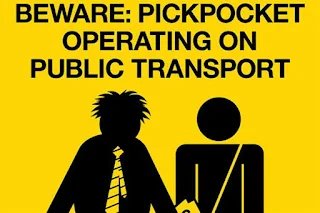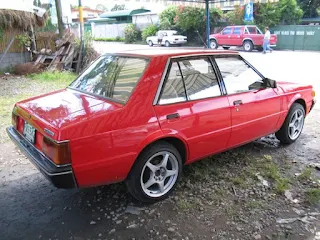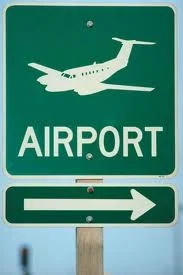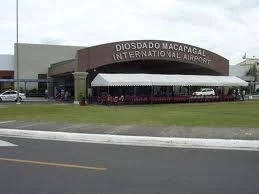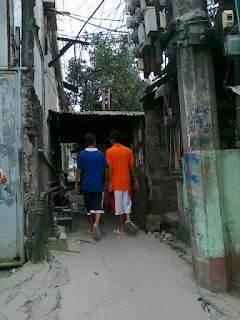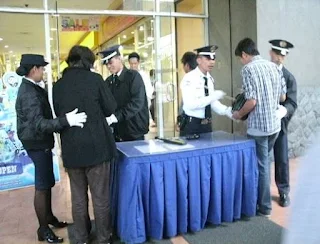 |
| Jeepneys in Philippines |
Advantages and Disadvantages of Riding in Jeepneys in the Philippines
The first time I was at the main immigration office in Manila I spoke with a clerk who advised me not to drive in the Philippines. The man told me "driving here is very different than driving in the USA." He suggested that if I did buy a car that it would be best to hire a driver. I took his advise and did not drive during my first 3 years in the Philippines.
Driving in the Philippines is VERY different than in the US. Someone has said that traffic laws and signs are considered merely suggestions here. One of the habits that amuses me here is that often two vehicles will pass a car at the same time. That's right three abreast and two of them are in the oncoming traffic lane! The two that are passing the other must fight to get back in the right lane before colliding with the oncoming vehicles. Talk about risking everything just to save a few minutes of travel time. I just read in the news (on July 5, 2012) that there had been over 20,000 traffic accidents in Metro Manila in the past 3 months.
I actually enjoyed not driving. My first few months in country I used taxis a lot. Taxis were not expensive and I liked being driven around in air conditioned luxury. But, there are many times that a taxi is not readily available. So, transportation choices then are to ride a bus, a tricycle or a jeepney.
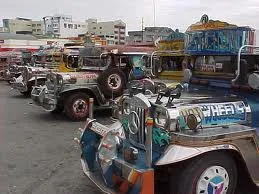 |
| A jeepney terminal |
Seems that the most frequent and the cheapest mode of travel is a jeepney. There are very few air conditioned jeepneys in the Philippines. Most have open air rear passenger compartments. There is usually roll down clear plastic sheeting to put down in event of rain. If rain is coming in, the driver will stop and lower the plastic coverings. There are no seatbelts in jeepneys, but they seldom travel very fast. Have never seen a jeepney accident.
As to travel time in a jeepney. It will take a little longer to get between two locations via jeepney than it will take in a taxi or a car. The jeepney stops for passengers along the way. When the driver sees someone nod or raise a hand he will stop to pick them up. I estimate that it would take about 15 minutes longer to travel from Magalang to SM City Clark by jeepney than it would take by car. Motorcycles are able to get there faster because they weave in and out of traffic and pass on the left OR right (although this is very dangerous).
You may want to travel by bus in the Philippines. Many buses are air conditioned. Buses cost a little more but usually take longer to reach one's destination because they stop for longer periods of time at their bus stops in order to take on the most passengers possible. Jeepneys seat only about 20 passengers so they tend to fill up faster. Advantages of buses are that one sits higher and thus above the thickest vehicle pollution. But, bus routes are usually only on the most heavily trafficked roadways. Jeepneys can be found on almost all roads. In Metro Manila there are more buses. Between provinces buses usually only ply the major highways linking the provinces.
One of my most memorable moments was when I exited the rear of a jeepney in a rural are outside of Angeles City.. Several students were seated near the rear door. One young lady said to me, "We are glad you're in the Philippines!" I said, "Thank you!"
When one is staying a long time in country it seems more feasible to travel like the locals. And, most of the locals ride in jeepneys. Travel by jeepney is the cheapest way to travel in the Philippines. One may travel a mile to several miles for 8 to 12 pesos (18 to 28 cents USA money). Here is a trick, instead of hiring a taxi to take you someplace it will probably be a lot cheaper to hire a jeepney. Just ask jeepney drivers if they will do a "private service" to wherever you need to go. For example, from SM City Clark in Angeles City you might hire a jeepney to take you and some new furniture back to your apartment for about 150 to 300 pesos. Or, in our case, we hired a "private jeepney" to take us and our luggage to the bus terminal for about 300 pesos. A taxi would charge about 600 to 900 pesos (it would need to travel round trip, from SM City Clark.). Or, if you need a ride to a hospital a jeepney will be cheaper and easier to find than a taxi. Just approach an empty jeepney at a jeepney terminal or on the street. You could ride a tricycle but a jeepney is a lot safer.
Compare that to the cost of bus fares in Florida, USA. A bus ride will cost $2.00 US or about 86 pesos (at the current exchange rate at the time of this writing on May 30, 2012.)
There are NO jeepneys in Florida, USA. In fact, I have never seen a jeepney anywhere in the USA. Maybe because of seat belt laws in the US.
It would be nice if there were jeepneys in the USA.
In the Philippines jeepneys can go where buses cannot go. They are everywhere! One never has to wait for a jeepney for more than a couple of minutes.
In the USA, one must walk to a bus stop, which may be a long distance from one's home or place of work. Then wait about 20 minutes for the next bus.
There are no seat belts in jeepneys. But, they usually travel at such slow speeds there are hardly ever any accidents resulting in injuries to passengers, as far as I know. I have never seen one in all the time I have been riding jeepneys.
There are "jeepney terminals" in downtown areas and at malls. At jeepney terminals many jeepneys wait their turn to carry passengers to surrounding areas. Drivers sleep while waiting their turn.
Entering the rear of a traditional jeepney
in Baretto Township near Subic Bay, Philippines
Most jeepneys carry about 22 passengers. Two benches in the rear, one on each side, 10 passengers on each bench and 2 more in the front seat. The seats have thin foam and a vinyl cover. Sometimes the bench covers are made from old vinyl signs.
Watch your head when boarding jeepneys!
Warning: be very careful when entering the rear of a jeepney. I have banged my head many times when pulling myself up in to the rear passenger compartment. Once, I almost knocked myself out. My head hit a steel bar so hard it made a loud bang noise. Two guys sitting near the door reached out to save me from falling back out onto the street. Fortunately it did not knock me out but it came close. I was still able to support myself.
Another hazard is light fixtures fastened to the center of the ceiling of many jeepneys. I have scratched or cut my head probably 30 times on these. Some jeepney ceilings are so low it is almost impossible for one to avoid the chrome steel fixtures. It can be hard to remember to duck down far enough, so, if you will wear a hat it will afford some protection.
Take a few moments to look at the top of the door opening and at the lights that may be fastened to the ceiling. Then pull yourself up slowly and climb into the jeepney. Move slowly and keep your head low to avoid hitting the light fixtures or screws or other things that may be protruding from the ceiling.
It is necessary to bend way over forward to "walk" to an open spot on a bench to sit down. Bending over in public is very foreign to North Americans. I felt very self-conscious for the first few months. But bending way over is good exercise and will help to keep one in good physical shape. It has worked for me.
Some people are just too tall or too large to fit into jeepneys or tricycles. Some jeepney passenger compartments are narrower than others. In a narrow jeepney it is very difficult to avoid stepping on other passengers' feet when entering and departing. If you cannot fit in the rear of the jeepney there may be a vacant seat next to the driver. You may try to fit into it. But, if you cannot then just wait for a larger jeepney or hail a tricycle or a taxi.
Drivers will usually understand English in the major metropolitan areas. Be sure to ask the driver to let you know when you have reached your destination. This is very important because it is virtually impossible to see out the side "windows" while riding. If you are over 5 feet tall you will be able to see the sidewalks but not buildings, signs or landmarks. If you bend down low you may be able to get an idea of where you are by looking out the front window. Try to sit in the front seat near the driver or if you are in the rear passenger compartment try to sit near the driver or move there when others exit the vehicle.
Jeepneys are color coded. For example, blue ones travel back and forth between two points via certain routes while yellow ones travel different routes to different destinations.
Manners and what to say in a jeepney
Manners dictate some unique actions when riding in a jeepney. If someone is entering the passenger compartment with a suitcase, package or other large items, be helpful. Often they will need assistance while going to an empty seat space or when departing the jeepney. Do like the Filipinos and help the package along to the seat or to the exit.If you are sitting by the rear door opening and you see someone who needs a hand to board the jeepney then extend your hand.
If a family boards try to move or make room so they can sit together.
Pass fare coins from other passengers forward to the driver. Just give the coins to the passenger next to you.
Try to have exact change for your own fare. If you pay more than exact fare you may or may not get change back. If you do not know the Filipino words to use to request your change it is easiest to just consider it a tip (which I am sure the driver's family probably needs and will appreciate.)
Some Filipino words to use when riding a jeepney
Ask a nearby passenger "mekano po" or "what is the fare to Sun Valley" to find out the cost of the fare.
When handing your fare to the driver say "bayad po" which means "here is the fare."
If you are near the rear door say "bayad" and pass your coins to a passenger near you, who will in turn pass it on to other passengers until it reaches the driver's hand.
The first time I paid the driver for my girlfriend and me I pronounced it wrong. I said, "bayag po, dalawa." All of a sudden a lot of giggling and smiles from the other passengers. It seems that bayag means "balls" in Tagalog. Po is the polite way to address a person and dalawa means "two." So, I had said "two balls, po." I smiled too, but I never said "bayag po" again. So, be careful to pronounce words correctly if you try to speak the language.
If you are going to Sun Valley subdivision, for example, tell the driver "I need to 'go down' at Sun Valley." Or, listen to what other passengers tell the driver.
When a passenger who requested "Sun Valley" gets off then you just follow him or her.
If the driver starts to step on the gas before you get off say "para, po" loud enough for him to hear you.
To learn more about what to say and do when riding in a jeepney go to this Wikipedia article and scroll down to the "Practices, Etiquette and Parlance" heading.
Be VERY cautious when getting out of a jeepney
Leaving Diosado Macapagal International Airport,
in the Clark Freeport Zone, in a Toyota Tamaraw FX (a type of van.)
in the Clark Freeport Zone, in a Toyota Tamaraw FX (a type of van.)
Read about my experiences with pickpockets while riding in jeepneys. On two occasions I have been the intended victim. Click on my "Pickpockets in the Philippines" article and see how I dealt with them.
Read an example of what happens to people who use weapons to rob jeepney passengers. They may be dealt with swiftly.
If you are interested in buying a jeepney visit this site to see a jeepney manufacturers in the Philippines. You may also want to visit my article about Buying a Used Car in the Philippines.
Jeepneys in the USA. I read an article about a couple who did bring a jeepney to the USA and are carrying passengers a city where there are many Filipinos in California. I imagine it must have been modified to meet US vehicle regulations.
Compare riding in jeepneys to riding in tricycles or riding in taxicabs.
If you are considering buying real estate in the Philippines.
Was this article helpful?
If you have found this article helpful, have suggestions, advice or insights please "comment" below.
This article will be updated. Check back to read more about jeepney travel. This page last updated June 4, 2022.
